Hoi An is one of Vietnam’s most beloved destinations, thanks to its charming scenery and personality. Exploring this small city on the central coast of Vietnam is a feast for the senses, with lots of sights to take in and foods to try. The city is an essential stop on any Vietnam itinerary, so you’ll want to make the most of your time there.
While it’s not a large city, you can spend quite a lot of time exploring Hoi An. Three days is long enough to cover the best places to visit in Hoi An, but once you begin to visit places nearby too, you’ll realize just how much this corner of Vietnam has to offer. That’s why we’ve put together this Hoi An itinerary to show you the best way to spend your three days in Hoi An. Let’s get into it, shall we?
Best Time to Visit Hoi An
As you plan your trip to Vietnam, think carefully about the timing of your visit. You need to consider not only the tourist high season, but also the fact that different parts of Vietnam experience completely separate weather and seasons from one another.
Sitting on the central coast of Vietnam, Hoi An really only has a dry season and a wet season. It’s generally agreed that the best time to visit Hoi An is during the dry season, which stretches from February to August. For cooler, more comfortable weather, consider visiting between February and April, but if heat and sun are what you want, wait until May or June. September is the closest Hoi An gets to a shoulder season, so that’s a good time to visit if your priorities are lower tourist numbers and more affordable accommodations.
The wet season in Hoi An generally runs from October to February. If you’re thinking of visiting during this period, you should know that the rain is heaviest in October and November, and flooding of the Ancient Town is not uncommon. The local wet season aligns with Vietnam’s high season as a whole, so you may not have much choice if you’re traveling across the country; just be prepared for weather disruptions.
How to Get Around Hoi An
With so much to see and do, you’ll want to know all your options for getting around while visiting Hoi An. Getting around the Ancient Town is simple; you should have no problem walking from one place to another as you explore the city’s historic center. But this itinerary extends far beyond the borders of the Ancient Town.
To get around on your own, you can rent bicycles and motorbikes, though the bicycles will probably only be useful for reaching the closest beaches. The daily rental costs are around 30,000 VND (about $1.27) for bicycles, 70,000 VND for electric bikes, and 150,000 VND for motorbikes. Less flexible options include taking a taxi or a Grab (Southeast Asia’s equivalent to Uber) or hiring a driver for the day.
There are several ways to reach Hoi An from Da Nang International Airport. The cheapest option is the local bus, which costs 30,000 VND for the trip, but it’s also the slowest, taking around 1.5 hours, and not ideal for carrying lots of luggage. A better option is the airport transfer shuttle, which is a little faster at roughly 1.25 hours and costs around 140,000 VND. Taking a taxi or private car is faster but considerably more expensive. You can book a private airport shuttle here.
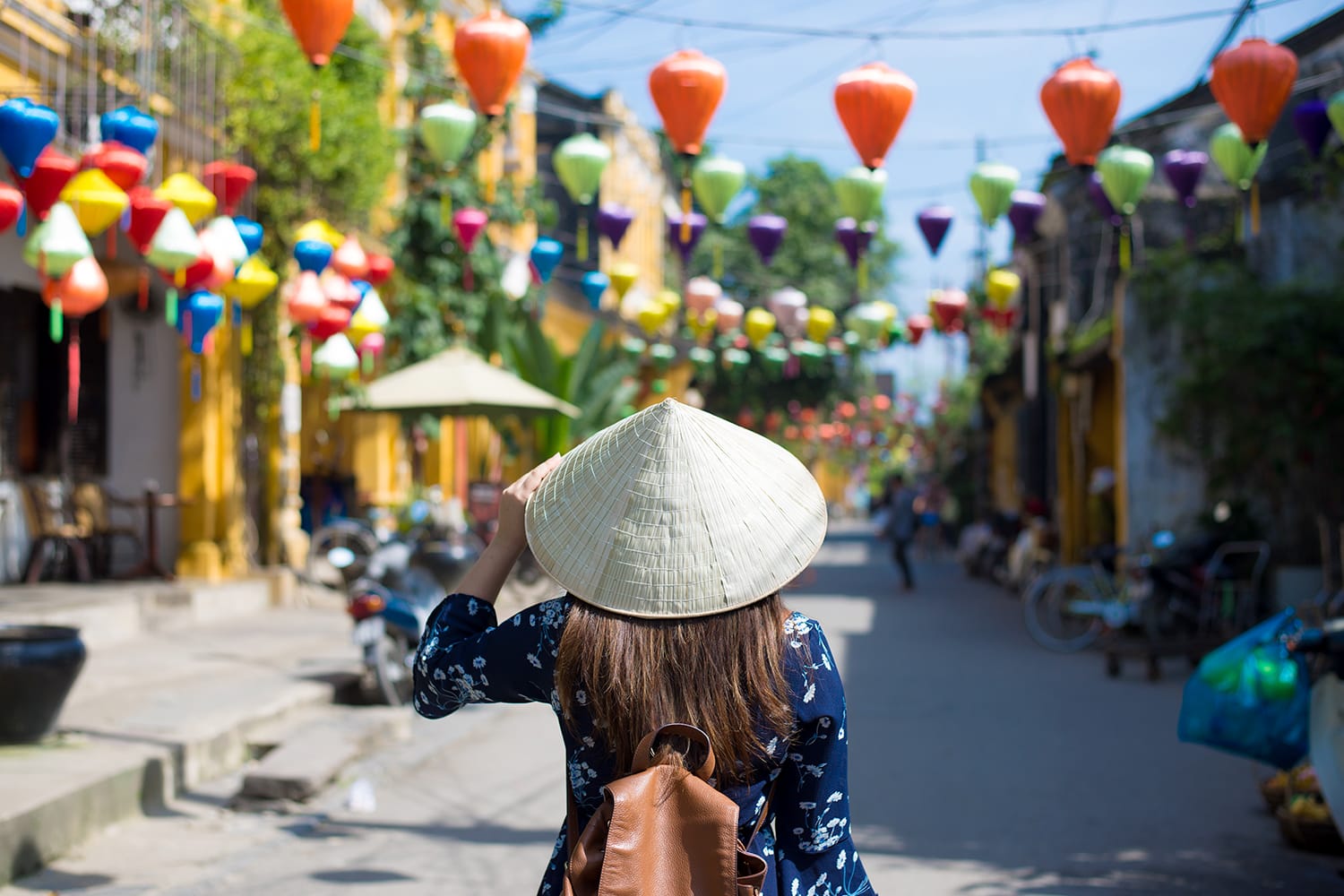
Where to Stay in Hoi An
Finding the right accommodation is a crucial step in any trip, as it can have a huge impact on your visit. The good news is that you have plenty of options in Hoi An, with lodgings to suit every budget and travel style. Still, to ensure you don’t miss out on the best places to stay in Hoi An, it’s best to book in advance. To help you work out where to stay in Hoi An, we’ll provide some suggestions and advice on where to look.
The closer you can stay to the Ancient Town, the better, as that’s where you’ll spend the bulk of your time. There are also clusters of accommodation about a kilometer to the north and east of the Ancient Town, including luxury hotels and villas that tend to be more affordable than the ones in the town center.
For a seriously luxurious stay, Little Riverside Hoi An is the way to go. This five-star hotel sits right on the banks of the Thu Bon River in the Ancient Town, offering stylish and spacious suites, a rooftop pool, and superb complimentary breakfast.
If you’re in search of both comfort and affordability, La An Central Boutique Villa is ideal for your visit. At this villa on the island of An Hoi, you can enjoy spacious rooms at a reasonable rate, great breakfast, and an outdoor swimming pool.
Hoi An is home to plenty of budget and backpacker accommodations too, Tribee Bana Hostel being one of the best options. This relaxed hostel has private rooms and dorms (with personal beds rather than bunks!), a funky common area, and an unbeatable location right in the heart of the Ancient Town. For more hostel recommendations, check out our hostel guide to Hoi An.
You can also find places to stay on Airbnb, which offers a wide range of price points and accommodation styles.
For more accommodation options in Hoi An, check out Booking.com. This site consistently offers the best rates, and its customer service is on point.
The Perfect 3-Day Hoi An Itinerary
Like most tourist destinations in Vietnam, Hoi An offers a wonderful variety of attractions to explore. Despite this wide selection, you’ll have no trouble covering the best things to do in Hoi An in three days, particularly around the Ancient Town. If you follow this Hoi An travel itinerary, you’ll even have enough time for a day trip to the beaches and one of the other awesome spots on Vietnam’s central coast.
However, before we get to our Hoi An itinerary, we just wanted to remind you to purchase travel insurance. You never know what will happen and, trust us, you do not want to get stuck with thousands of dollars in medical bills. As a wise man once said, “If you can’t afford travel insurance, you can’t afford to travel.” So don’t leave home without it.
SafetyWing offers travel insurance for only about $10 a week, making it a no-brainer to get. You can get a quick, non-binding quote below:

SafetyWing is, of course, not the only option available. Two other popular alternatives are World Nomads and Heymondo.
Having considered that important matter, you can now dive into the best of Hoi An with this itinerary. Below, you’ll find a flexible outline of what to do in Hoi An in three days to enjoy your time in this colorful city.
Hoi An Itinerary: Day 1
It’s best to start your first day by exploring the various attractions and markets around the Hoi An Ancient Town.
Hoi An Central Market
Begin with a visit to the Hoi An Central Market. The market often gets busy later in the day, so a morning start is a good idea – especially because you can get breakfast and watch local fishermen bring in their catches to sell.
Throughout the market, you’ll find all manner of things for sale, such as textiles, handicrafts, local produce, and spices. Inside the market is a food court where you can get meals, while snacks and coffee are hawked around the outside. Even if you don’t buy anything during this visit, you’ll get a good idea of the local prices for food and souvenirs.

Ancient Town
Much of what makes Hoi An so special as a tourist destination relates to its incredibly well-preserved historic center, said to have been settled for at least 2,000 years. Known either as the Ancient Town or Old Town, this central part of Hoi An survived the Vietnam War mostly unscathed, retaining plenty of old-fashioned character and earning a spot on the UNESCO World Heritage Site List.
The Hoi An Central Market is actually in the Ancient Town, so feel free to wander around its immediate area. You’ll find faded yellow merchant houses and lanterns along either side of every street, creating the wonderful scenery Hoi An is famous for.
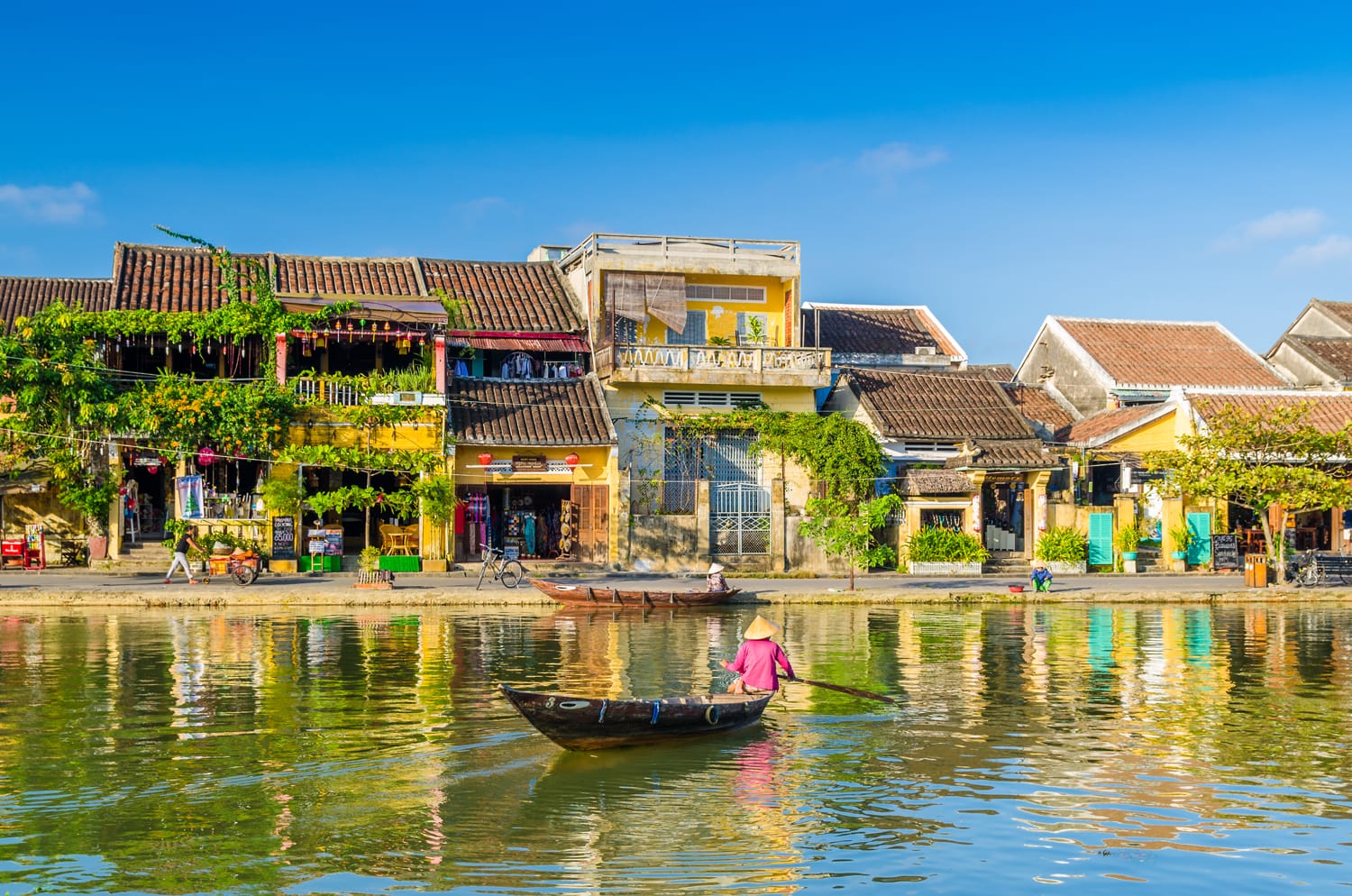
Japanese Covered Bridge
Perhaps the single most iconic landmark in Hoi An is the Japanese Covered Bridge in the Ancient Town. This well-preserved bridge from the 16th century once connected the Japanese and Chinese communities of the city. Thanks to its beautifully ornate carvings, the bridge is a firm favorite among photographers and local couples looking to have their photo taken.
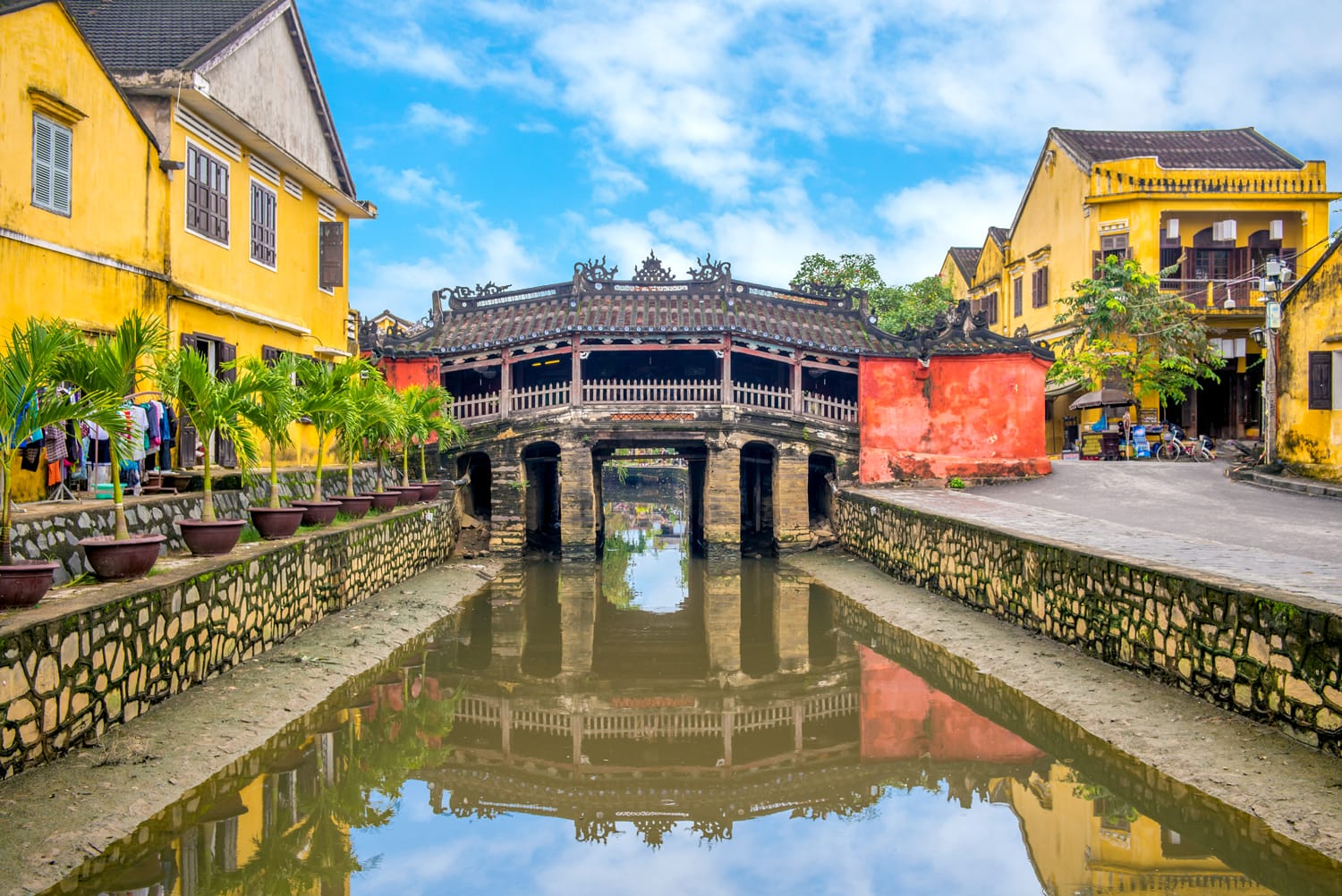
Old Houses
Next, pay a visit to some of the old houses of Hoi An that have been opened up to tourists. These historic residences allow you to see what the traditional homes look like inside, while learning about the city’s history through the stories of the families that lived in them.
The Old House of Tan Ky is probably the most popular one to visit, belonging to the descendants of a wealthy family of local merchants. Built in the 18th century, it incorporates a mix of Japanese, Chinese, and traditional Vietnamese architecture, along with antique furniture and assorted memorabilia. You can take a guided tour if you’d like to learn more about the family and their lives. Another historic home is the Old House of Phung Hung, featuring a colorful entrance hall and a pleasant balcony area.
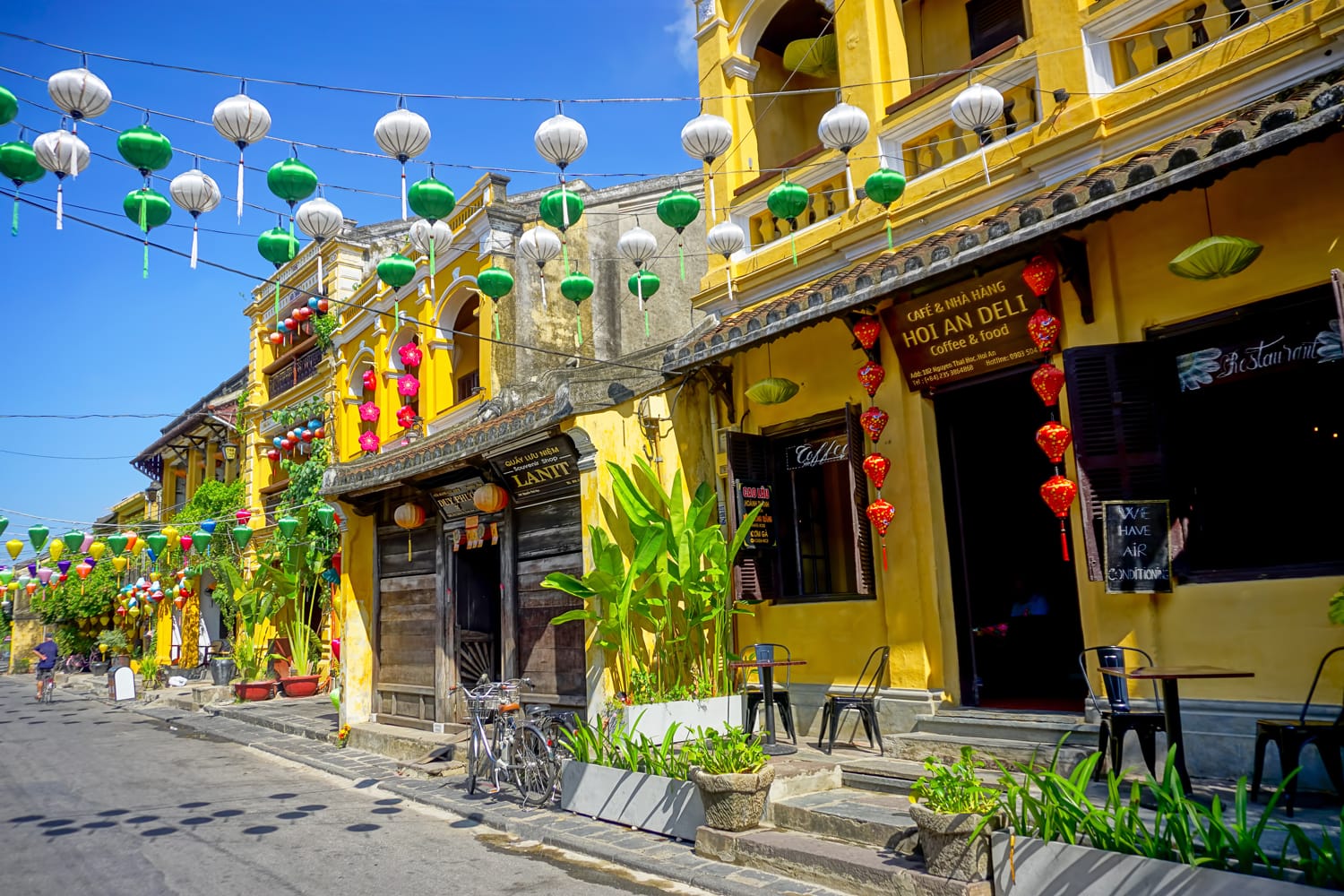
Fujian Assembly Hall
Hoi An’s popularity as a tourist destination is largely thanks to its colorful scenery, and one of its most vibrant landmarks is the gate to the Fujian Assembly Hall. Originally just a pagoda built by Vietnamese locals in the 17th century, it was sold to Hoi An’s Fujian-born community as a place to socialize. While described as an assembly hall, it’s really more of a place of worship, especially as the Jinshang Golden Mountain Temple is considered the heart of the complex. There are quite a few things to see here, but the gorgeous pink and green gate is certainly the most photogenic.
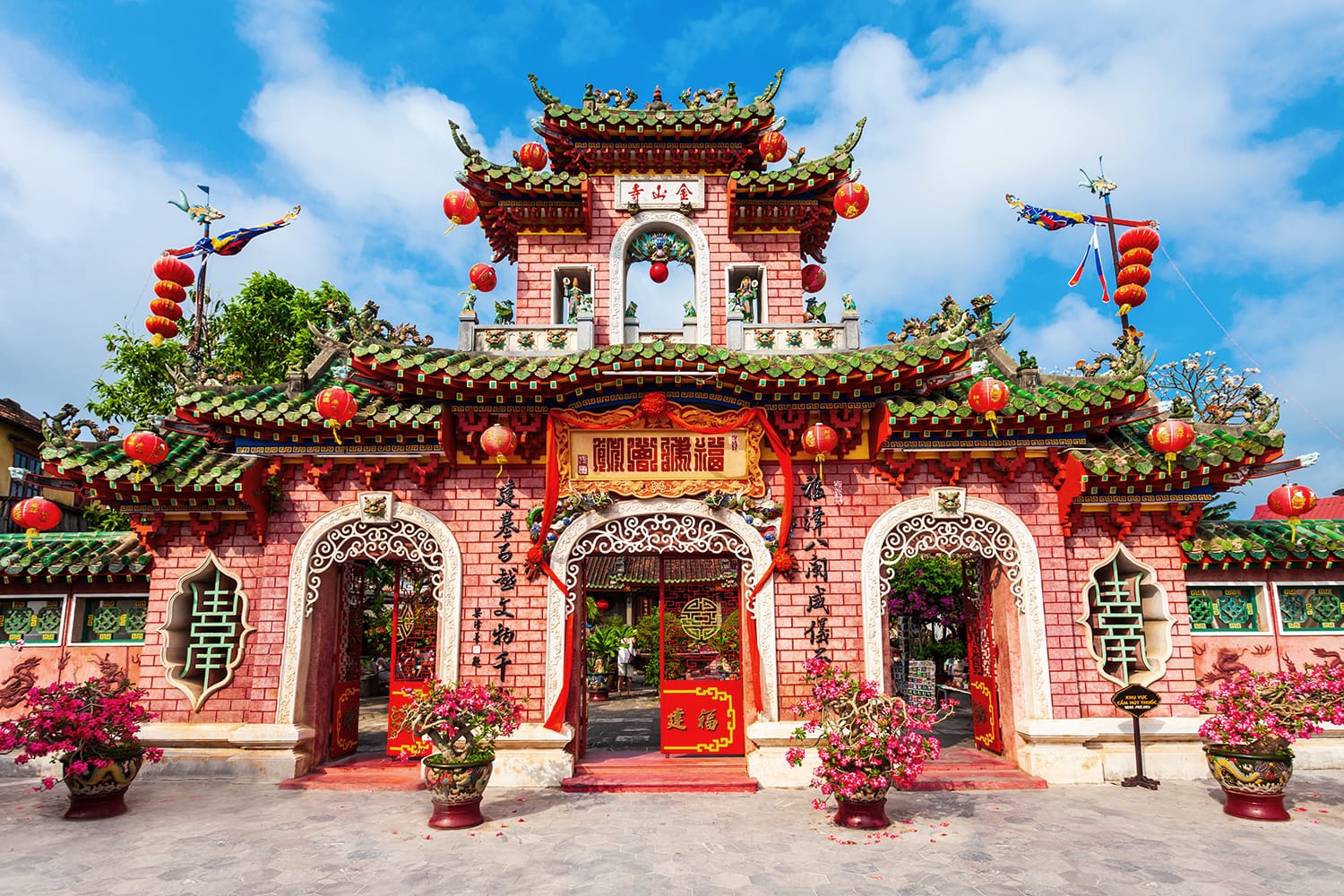
Precious Heritage Art Gallery Museum
To learn just how diverse Vietnam is, head over to the Precious Heritage Art Gallery and Cultural Museum. There you’ll find an exhibition that explores the culture and heritage of Vietnam’s many ethnic tribes through portraits, stories, and traditional outfits. This free museum is the life’s work of French migrant Réhahn, who has spent years studying and sharing the traditions of the 54 ethnic tribes and subgroups across the country.
Night Market
The ideal way to end your first day – and really any day in Hoi An – is at the city’s treasured Nguyen Hoang Night Market. Every night, the streets around the island of An Hoi fill up with stalls selling food, clothes, and all sorts of other items. The Night Market is a true spectacle and a delight to the senses, with the incredible sight of thousands of lanterns and the tempting smells of cheap snacks like banh mi and banh xeo. If you’re lucky, you may even catch the monthly Hoi An Lantern Festival, where a flotilla of small paper lanterns drift down the nearby river.

Hoi An Itinerary: Day 2
While you could easily fill your day with visits to local tailors or cooking courses, you should make the most of the nearby seaside for at least part of the day. Here are some quality beaches you can easily access from Hoi An.
Cua Dai Beach
The most famous beach near Hoi An is Cua Dai, running along the nearest stretch of coast from the city. Cua Dai Beach sprawls on for 3 kilometers, allowing plenty of space for beachgoers. Its popularity comes from the combination of fine white sand to lie on, clear blue water to swim in, and willow trees that provide a little shade.
You have plenty of options to rent sun loungers and parasols here, while hawkers with food and drinks regularly walk up and down the beach. Admittedly, with the hawkers and weekend crowds, Cua Dai isn’t usually the most peaceful beach. The upside of this popularity is that there’s no shortage of seafood restaurants and bars nearby.
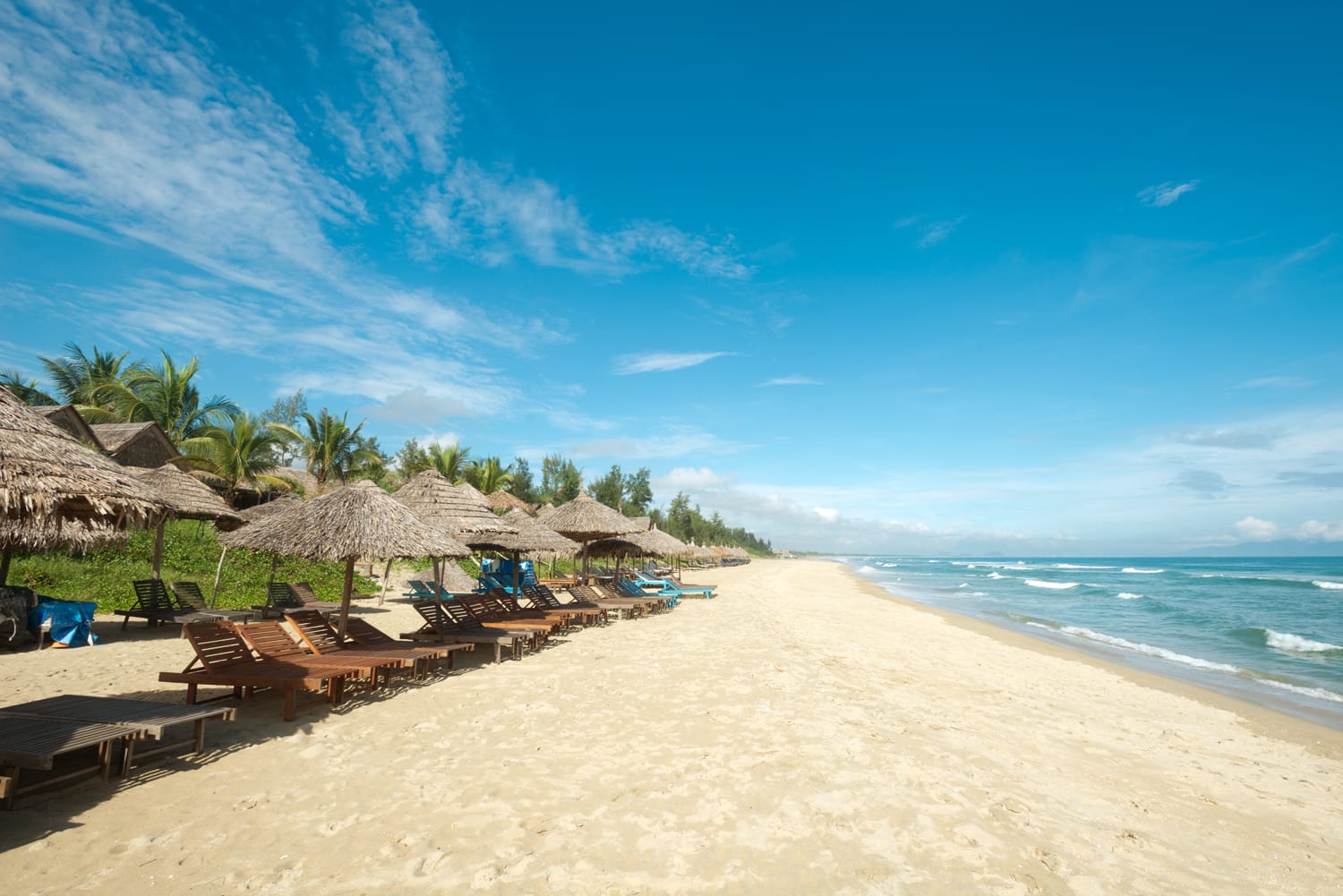
An Bang Beach
A quieter alternative to Cua Dai for Hoi An beachgoers is to continue north along the coast to An Bang. This beach is a local favorite that tends to see fewer people and still offers flawless white sand. An Bang Beach is also free from the kind of commercial development that sometimes ruins the relaxed atmosphere of Vietnam’s beaches, though you can still find seafood restaurants and bars just back from the waterfront.
You can rent sun beds at An Bang Beach, as well as surfboards and stand-up paddleboards. In case you’ve never tried these water sports, you can even take lessons here before taking your board rentals for a spin.
Recommendation: If you don’t want to spend the whole day lying on the beach, consider joining this amazing eco tour. You’ll get to visit a local market, cruise down the Thu Bon River, and take a hands-on cooking class, with plenty of time left to visit the beach afterward.
Da Nang
Rather than visit the beaches near Hoi An, you could journey up to the city of Da Nang and see what its coast is like. Da Nang doesn’t have the kinds of historical sights Hoi An is known for, being known for its beaches instead.
My Khe Beach and Non Nuoc Beach are generally considered the best beaches in Da Nang. My Khe is a city beach that’s central to Da Nang and the closest section of the beachfront that stretches right along the coast here. With city streets immediately behind it, you can easily reach restaurants and spas from the beach.
Non Nuoc Beach, on the other hand, is down at the south end of the city and surrounded by resorts. What’s nice about Non Nuoc is its calm surf and particularly unpolluted sand and water.
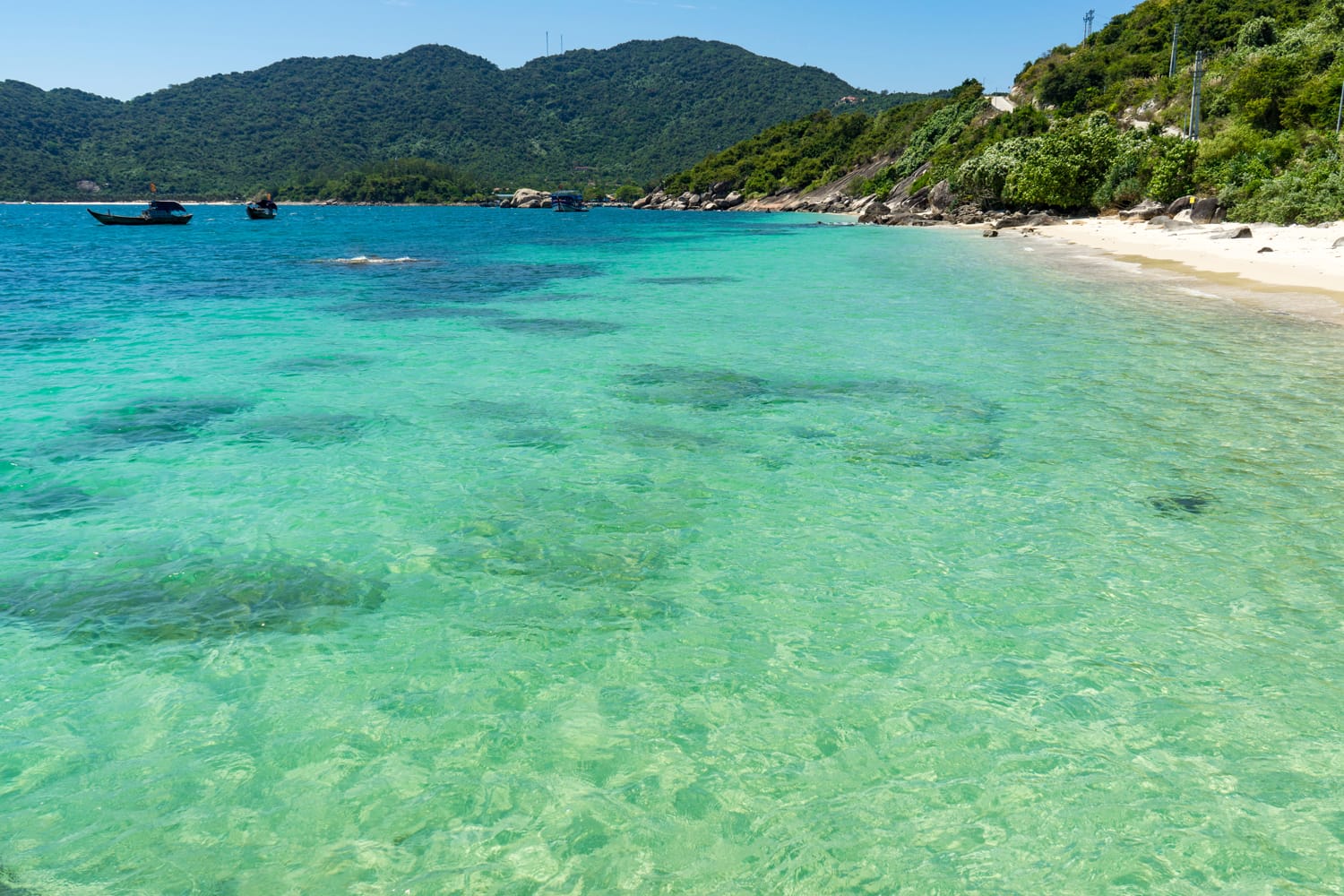
Cham Islands
Yet another option is to leave the mainland and take a boat ride out to the Cham Islands. This collection of eight islets off the coast of Hoi An is only accessible during the dry season, but it’s worth the journey when possible. The most popular activities here are snorkeling and scuba diving in the Cu Lao Cham Marine Park. If you’re still looking to relax on the sand, head over to Hon Lao Island, where you’ll find a pristine beach. You can book a boat trip to the Cham Islands here.
Hoi An Itinerary: Day 3
Rounding out your 72 hours in Hoi An, look a little beyond Hoi An to discover other great destinations on Vietnam’s central coast. Choosing a Hoi An day trip will add another dimension to your vacation and help you customize your itinerary.

1. Marble Mountains
One of the easiest and most rewarding day trips from Hoi An is to head north to the Marble Mountains. Spiritually significant as well as beautiful, this striking cluster of five limestone and marble mountains is hard to miss against the flat coastal countryside between Hoi An and Da Nang.
Mount Thuy is the largest mountain of the five and the only one you’re allowed to climb. Seemingly endless staircases wind their way up the mountain, with small pauses to show you pretty shrines and temples such as the Non Nuoc Pagoda. Mount Thuy is also home to several caves, including Huyen Khong Cave, which actually contains a wonderfully atmospheric Buddhist shrine.
Keep climbing until you reach one of Mount Thuy’s summits. This will be well worth the hike, as you’ll have some magical views of the rest of the Marble Mountains on one side and the stunning coastline on the other.
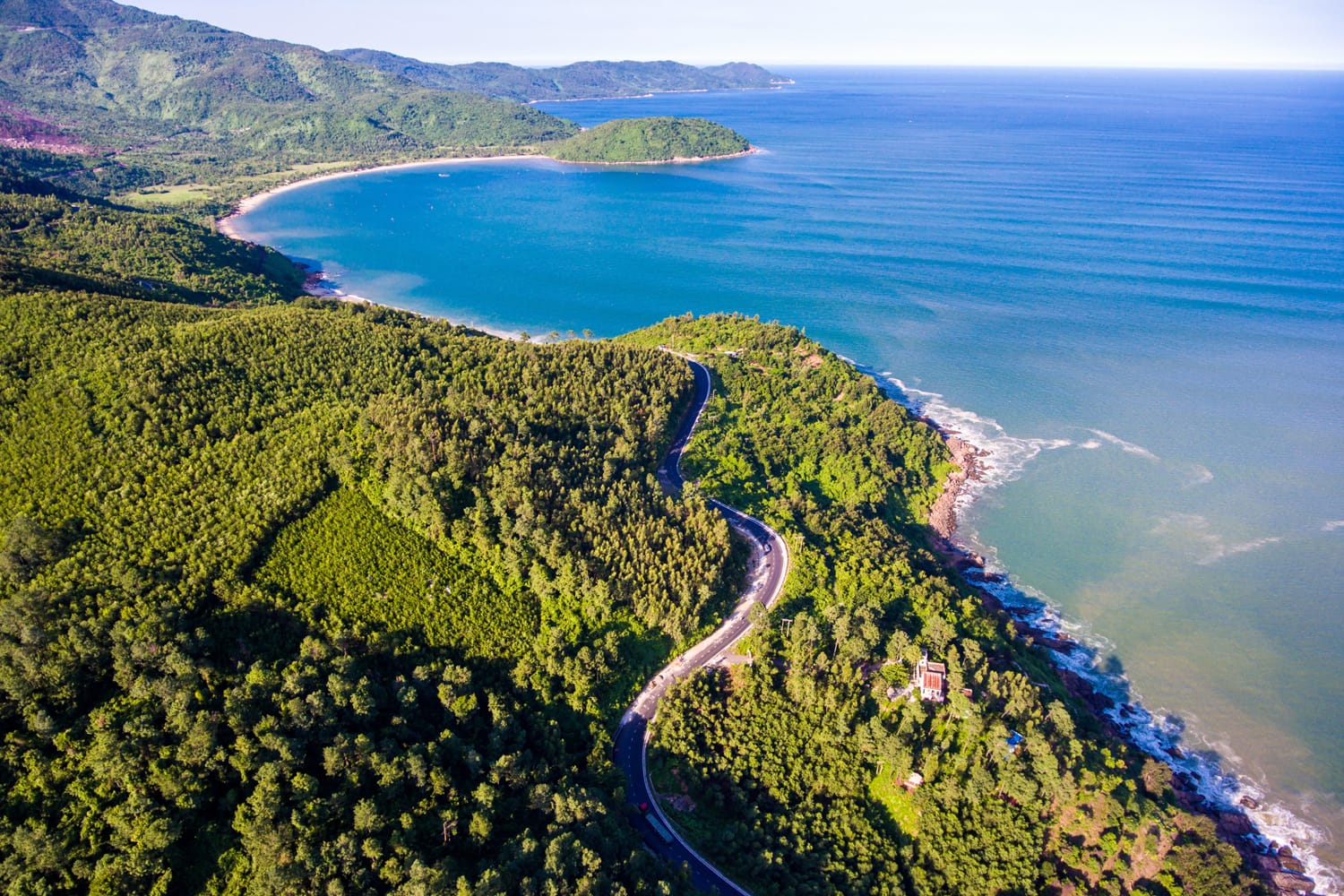
2. Hai Van Pass
The central coast of Vietnam is famous for having one of the country’s most scenic roads, the Hai Van Pass. This winding road carves through the coastal mountains north of Da Nang, making for the ultimate road trip in Vietnam.
The Hai Van Pass owes much of its popularity, at least with Westerners, to the “Vietnam Special” episode of the TV show Top Gear, in which the hosts drove down the road on motorbikes and raved about the scenery. Even though it lies on the well-traveled route between Hue and Hoi An, few get to see its incredible coastal views, as most transport takes a modern tunnel through the mountains instead. In other words, if you want to see the Hai Van Pass, it’s best to make a day of it.
Since your transport is integral to this day trip, there are a few things you should know. To ride the Hai Van Pass, you can either rent a motorbike, first ensuring you have the appropriate license and insurance, or take a motorbike tour that covers those issues for you. Either way, this road and its landscape provide an incredible experience.
Book Motorbike Tour over Hai Van Pass

3. Ba Na Hills
Easily the hottest day-trip destination from Hoi An right now is the Ba Na Hills to the west of Da Nang. Once a hill station resort built by the French in the early 20th century, the Ba Na Hills are now a resort theme park that must be seen to be believed. You won’t encounter anywhere else quite like this in Vietnam.
The most famous landmark in the Ba Na Hills these days is the Golden Bridge, which opened in 2018 to much fanfare. This elevated pedestrian bridge was all over Instagram then, thanks to the mesmerizing design of two giant hands holding it up.
But there’s more to the Ba Na Hills than you may realize, including a substantial replica of a French village, complete with its own scaled-down Notre Dame Cathedral. The German beer garden, alpine slide, and other amusement park rides will also make you forget you’re in Vietnam.
This ends our guide to sightseeing around Hoi An in three days. It should now be clear just how many options you have for your time there – but no matter how you spend your visit, it’s unlikely to disappoint.

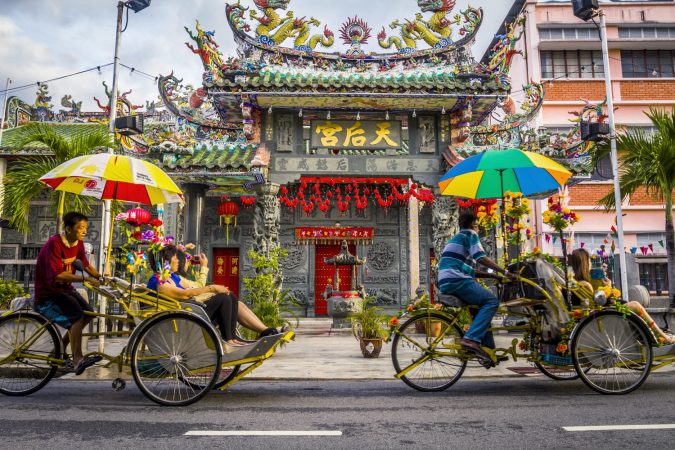






Comments